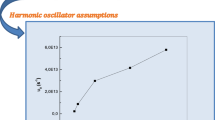Abstract
When quantum scattering theory is applied strictly from the point of view that the state of a system is completely described by the density matrix, whether pure or mixed, it is not possible to assume that colliding particles are at all times individually in pure states. Exact results are significantly different from conventionally accepted approximations. In particular, it turns out that the cross section as ordinarily defined in theS-matrix formalism is an adequate parameter for deciding the outcome of interactions only when the particles are carefully prepared in matching pure states. In general the use of the cross section in studying pair collisions in a real gas is shown to be analogous to a repeated “collapse of the wave function” after each collision, and involves arbitrary removal of nondiagonal elements of the density matrix, thus violating the basic laws of quantum dynamical evolution.
Similar content being viewed by others
References
M. L. Goldberger and K. M. Watson,Collision Theory (Wiley, New York, 1964).
J. von Neumann,Mathematical Foundations of Quantum Mechanics (Princeton U. P., Princeton, N. J., 1955), p. 426.
J. R. Taylor,Scattering Theory (Wiley, New York, 1972).
Author information
Authors and Affiliations
Rights and permissions
About this article
Cite this article
Band, W., Park, J.L. Some fundamental difficulties with quantum mechanical collision theory. Found Phys 8, 677–694 (1978). https://doi.org/10.1007/BF00717499
Received:
Issue Date:
DOI: https://doi.org/10.1007/BF00717499




